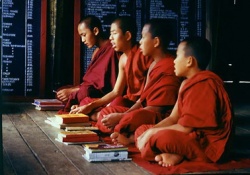Difference between revisions of "Lāma"
Jump to navigation
Jump to search
(Created page with "thumb|250px|[[File:|thumb|250px|]] Lāma is a Tibetan word literally meaning ‘the highest’ or ‘superior.’ It is a title given to particularly esteem...") |
|||
| (4 intermediate revisions by 2 users not shown) | |||
| Line 1: | Line 1: | ||
| − | [[File:Bud4.jpeg|thumb|250px|]][[ | + | [[File:Bud4.jpeg|thumb|250px|]] |
| − | + | <poem> | |
| + | [[Lāma]] is a [[Tibetan]] [[word]] literally meaning ‘the [[highest]]’ or ‘{{Wiki|superior}}.’ It is a title given to particularly esteemed [[Dhamma]] [[teachers]], whether they be [[monks]] or [[layman]], and also to those believed to be famous [[teachers]] of the {{Wiki|past}} [[reborn]] into the {{Wiki|present}}. Ordinary [[monks]] are never called [[lāma]]. [[Tibetans]] take not three but four [[refuges]], the first [[being]] ‘I take [[refuge]] in the [[lama]].’ This is a major departure from classical [[Buddhism]] and is a practice unique to [[Vajrayāna]]. | ||
| + | |||
| + | See [[Dalai Lāma]]. | ||
| + | </poem> | ||
{{R}} | {{R}} | ||
[http://www.buddhisma2z.com/content.php?id=220 www.buddhisma2z.com] | [http://www.buddhisma2z.com/content.php?id=220 www.buddhisma2z.com] | ||
Latest revision as of 02:39, 25 December 2014
Lāma is a Tibetan word literally meaning ‘the highest’ or ‘superior.’ It is a title given to particularly esteemed Dhamma teachers, whether they be monks or layman, and also to those believed to be famous teachers of the past reborn into the present. Ordinary monks are never called lāma. Tibetans take not three but four refuges, the first being ‘I take refuge in the lama.’ This is a major departure from classical Buddhism and is a practice unique to Vajrayāna.
See Dalai Lāma.
